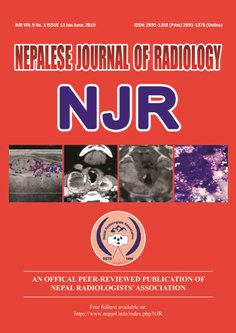Study of Role of Ultrasonography in Evaluation of Thyroid Nodules
DOI:
https://doi.org/10.3126/njr.v9i1.24780Keywords:
Thyroid nodule, Ultrasonography, Thyroid Neoplasms, Sensitivity and SpecificityAbstract
Introduction: Thyroid nodules are a very common clinical finding which can be single ormultinodular and benign or malignant. Ultrasonography (USG) followed by USG guided fineneedle aspiration cytology (FNAC) is usually done in evaluating any thyroid nodule that ispalpable on physical examination. The purpose of this study was to study the role of USG in evaluating thyroid nodules and its correlation with findings of FNAC of thyroid.
Methods: One hundred and twenty five patients with palpable thyroid referred for USG neckwere included in the study. Ultrasonography assessments of thyroid with different parameters were done. The findings were later compared with FNAC thyroid.
Results: On FNAC and histological analysis, thyroid malignancy was observed in 14 out of 125 (11.21%) subjects. Malignant nodules on USG demonstrated hypoechoic pattern (sensitivity 82.3%, specificity 97.2%, and positive predictive value 82.3%), irregular margins (sensitivity 77.8%, specificity 96.3%, and accuracy 77.8%), central vascularity (sensitivity 82.3%, specificity 95.4%, and positive predictive value 73.7%) and taller-than-wider shape (sensitivity 82.3%, specificity 96.3%, and accuracy 77.8%). Sixteen cases with suspicion of malignant thyroid nodules demonstrated these 2 or more USG features. Sensitivity, specificity and positive predictive value of thyroid nodules for detecting malignancy increased to 87.5%, 98.2% and 87.5% respectively when two or more of these USG features were present.
Conclusions: Thyroid USG demonstrating hypoechoic pattern, irregular margins, centralvascularity and taller-than-wider shape had potential of being malignant. Thyroid nodules were found to have more malignant potential when two or more of these USG features were present.
Downloads
Downloads
Published
How to Cite
Issue
Section
License
This license enables reusers to distribute, remix, adapt, and build upon the material in any medium or format, so long as attribution is given to the creator. The license allows for commercial use.




